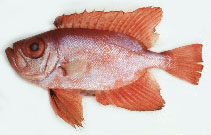| Family: |
Priacanthidae (Bigeyes or catalufas) |
| Max. size: |
35 cm SL (male/unsexed) |
| Environment: |
demersal; marine; depth range - 350 m |
| Distribution: |
Indo-West Pacific: Red Sea and Reunion to Japan, northern Australia and Samoa. Mediterranean (Ref. 96612). |
| Diagnosis: |
Dorsal spines (total): 10-10; Dorsal soft rays (total): 13-14; Anal spines: 3-3; Anal soft rays: 13-15. Medium-sized fish. The body is oval; dorsal fin continuous; eyes very large; mouth large and oblique; preopercular spine short and broad. The head and body reddish silvery or, alternately, pale yellowish with gray mottling; the iris of the eye pink to bright red. The dorsal, anal, and caudal fins pink with reddish-brown spots in the membranes, or yellowish with dusky spots. This species resembles P. blochii, but differs from it by having pointed soft dorsal and anal fins, and black membrane between the first and the second dorsal spine. |
| Biology: |
In sheltered reefs in moderate depths, usually in caves or under coral plates (Ref. 48635); may also be found in rocky and open areas. Solitary (Ref 90102). |
| IUCN Red List Status: |
Least Concern (LC); Date assessed: 10 March 2015 Ref. (130435)
|
| Threat to humans: |
harmless |
Source and more info: www.fishbase.org. For personal, classroom, and other internal use only. Not for publication.

